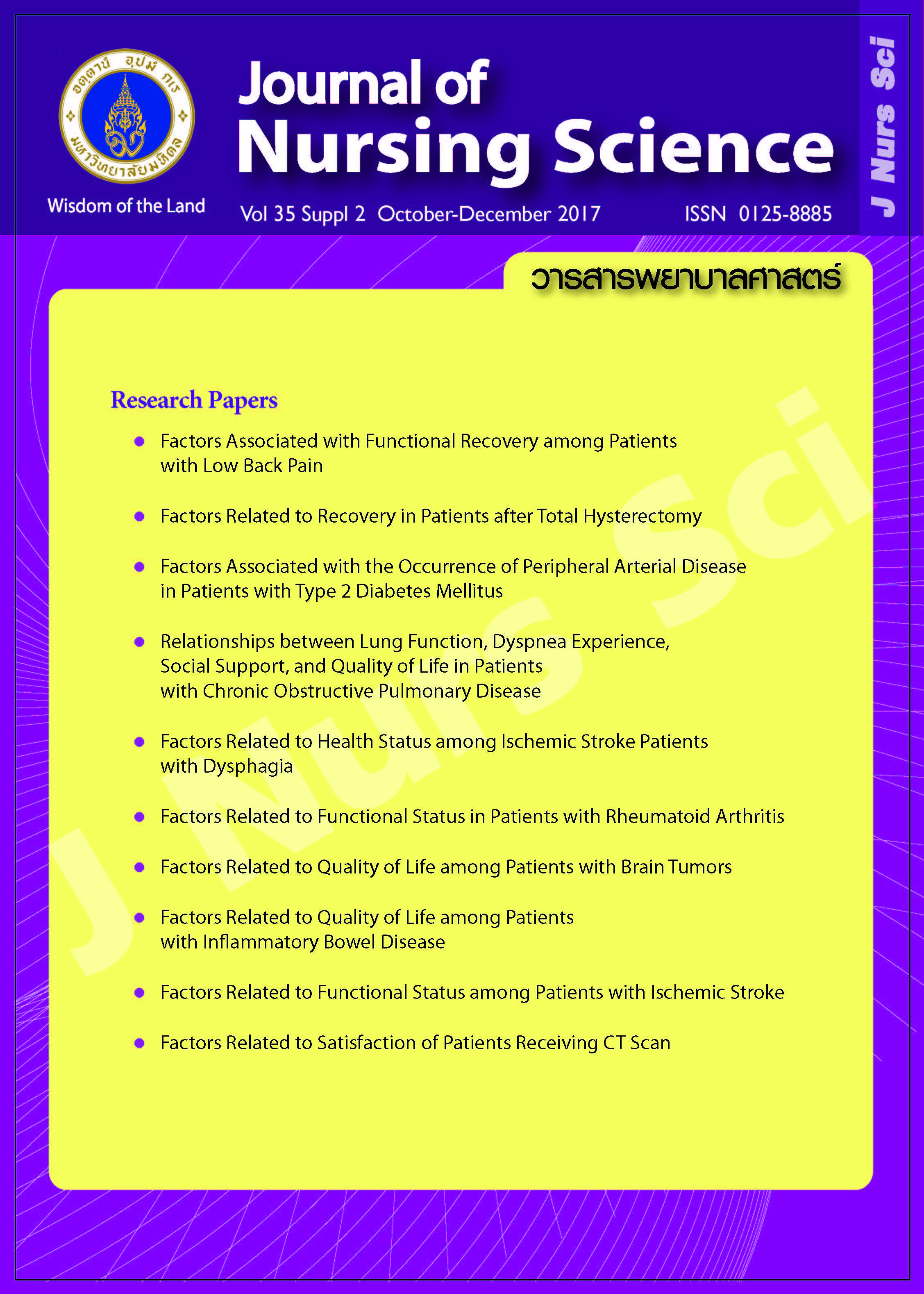Factors Associated with the Occurrence of Peripheral Arterial Disease in Patients with Type 2 Diabetes Mellitus ปัจจัยที่มีความสัมพันธ์กับการเกิดโรคหลอดเลือดแดงส่วนปลายในผู้ป่วยเบาหวานประเภทที่ 2
Main Article Content
Abstract
Purpose: To study the occurrence of peripheral arterial disease (PAD) and factors associated with the occurrence of PAD among patients with type 2 diabetes mellitus (T2DM).
Design: Descriptive design.
Methods: The sample composed of 136 adult patients with T2DM who were treated at Bach Mai hospital, Hanoi, Vietnam. Data were collected using Ankle Brachial Index (ABI) to assess the occurrence of PAD, and 4 questionnaires: patients’ demographic data, clinical information, the self-efficacy for diabetes, and knowledge about PAD. Chi – Square was employed to test association between studied variables.
Main findings: The findings revealed that 16.18% had PAD; 36.36% of those with PAD had stage 4-ulceration or gangrene; 63.64% had location of PAD at tibia-peroneal artery and 31.81% at femoro-popliteal artery. Co-morbid diseases, HbA1c, and self-efficacy were significantly associated with the occurrence of PAD (p < .05). There was no association between the occurrence of PAD and knowledge about PAD (p > .05).
Conclusion and recommendations: Nurses can empower patients with T2DM to increase self-efficacy as well as providing them with information to control the level of HbA1c and co-morbid diseases.
บทคัดย่อ
วัตถุประสงค์: เพื่อศึกษาการเกิดโรคหลอดเลือดแดงส่วนปลาย และปัจจัยที่มีความสัมพันธ์กับการเกิดโรคหลอดเลือดแดงส่วนปลาย ในผู้ป่วยเบาหวานประเภทที่ 2
รูปแบบการวิจัย: การวิจัยเชิงบรรยาย
วิธีดำเนินการวิจัย: กลุ่มตัวอย่างเป็นผู้ป่วยเบาหวานประเภทที่ 2 ที่มารับการรักษาตัวที่โรงพยาบาลบัคมาย ประเทศเวียดนาม เก็บข้อมูลด้วยการประเมินการเกิดโรคหลอดเลือดแดงส่วนปลาย ด้วยการวัดดัชนีความดันเลือดเทียบหลอดเลือดแดงแขนกับขา และแบบสอบถาม จำนวน 4 ชุด: แบบสอบถามข้อมูลส่วนบุคคล แบบสอบถามข้อมูลทางคลินิกและโรคร่วม แบบสอบถามการรับรู้สมรรถนะในตนเองด้านการดูแลและควบคุมโรคเบาหวาน และแบบสอบถามความรู้เกี่ยวกับโรคหลอดเลือดแดงส่วนปลาย ใช้สถิติ ไคสแควร์เพื่อทดสอบความสัมพันธ์ระหว่างตัวแปร
ผลการวิจัย: กลุ่มตัวอย่างร้อยละ 16.18 เกิดโรคหลอดเลือดแดงส่วนปลาย ร้อยละ 36.36 ของผู้ที่เกิดโรคหลอดเลือดแดงส่วนปลาย เป็นระยะที่ 4-ulceration or gangrene ร้อยละ 63.64 เกิดที่ตำแหน่ง tibia-peroneal artery และร้อยละ 31.81 เกิดที่ตำแหน่ง femoro-popliteal artery การมีโรคร่วม ระดับน้ำตาลสะสม และการรับรู้สมรรถนะในตนเองมีความสัมพันธ์กับการเกิดโรคหลอดเลือดแดงส่วนปลาย (p < .05) แต่ความรู้เกี่ยวกับโรคหลอดเลือดแดงส่วนปลายไม่มีความสัมพันธ์กับการเกิดโรคหลอดเลือดแดงส่วนปลาย (p > .05)
สรุปและข้อเสนอแนะ: พยาบาลสามารถใช้วิธีการสร้างความมั่นใจและสร้างพลังเพื่อส่งเสริมให้ผู้ป่วยเบาหวานประเภทที่ 2 รับรู้สมรรถนะในตนเองเพิ่มขึ้น ร่วมกับการให้ข้อมูลความรู้ในการควบคุมระดับน้ำตาลสะสม และควบคุมภาวะโรคร่วม ทั้งนี้เพื่อลดอัตราการเกิดโรคหลอดเลือดแดงส่วนปลาย
Article Details
Copyright Notice: Nursing Science Journal of Thailand has exclusive rights to publish and distribute the manuscript and all contents therein. Without the journal’s permission, the dissemination of the manuscript in another journal or online, and the reproduction of the manuscript for non-educational purpose are prohibited.

Disclaimer: The opinion expressed and figures provided in this journal, NSJT, are the sole responsibility of the authors. The editorial board bears no responsibility in this regard.
References
2. Selvin E, Erlinger TP. Prevalence of and risk factors for peripheral arterial disease in the United States: results from the National Health and Nutrition Examination Survey, 1999-2000. Circulation. 2004;110(6):738-43.
3. McDermott MM. The magnitude of the problem of peripheral arterial disease: epidemiology and clinical significance. Cleve Clin J Med. 2006;73 Suppl 4:S2-7.
4. Marso SP, Hiatt WR. Peripheral arterial disease in patients with diabetes. J Am Coll Cardiol. 2006;47(5):921-9.
5. Hiatt WR, Armstrong EJ, Larson CJ, Brass EP. Pathogenesis of the limb manifestations and exercise limitations in peripheral artery disease. Circ Res. 2015;116(9):1527-39.
6. American Diabetes Association. Diagnosis and classification of diabetes mellitus. Diabetes Care. 2013;36 Suppl. 1:67-74.
7. Potier L, Abi Khalil C, Mohammedi K, Roussel R. Use and utility of ankle brachial index in patients with diabetes. Eur J Vasc Endovasc Surg. 2011;41(1):110-6.
8. Endocrinology Department. Annual report of Endocrinology Department 2014. Hanoi: Endocrinology Department, Bach Mai Hospital; 2015.
9. Bandura A. Self-efficacy: the exercise of control. New York: Worth Publishers; 1997.
10. Collins TC, Lunos S, Ahluwalia JS. Self-efficacy is associated with walking ability in persons with diabetes mellitus and peripheral arterial disease. Vasc Med. 2010;15(3):189-95.
11. Vasaroangrong T, Thosingha O, Riegel B, Ruangsetakit C, Viwatwongkasem C. Factors influencing prehospital delay time among patients with peripheral arterial occlusive disease. Eur J Cardiovasc Nurs. 2016;15(4):285-93.
12. Faul F, Erdfelder E, Buchner A, Lang AG. Statistical power analyses using G*Power 3.1: tests for correlation and regression analyses. Behav Res Methods. 2009;41(4):1149-60.
13. Cohen J. A power primer. Psychol Bull. 1992;112(1):155-9.
14. Self-Management Resource Center. Self-efficacy for diabetes scales [Internet]. [cited 2017 May 15]; Available from: https://www.selfmanagementresource.com/docs/pdfs/English_-_self-efficacy_diabetes.pdf.
15. Lorig K, Ritter PL, Villa FJ, Armas J. Community-based peer-led diabetes self-management: a randomized trial. Diabetes Educ. 2009;35(4):641-51.
16. Carter C, Martinez M, Purnell G, Chesbro SB. Screening for peripheral arterial disease in a long-term care setting: considerations for clinical practice. Top Geriatr Rehabil. 2013;29(3):203-9.
17. Wongkongkam K, Thosingha O, Riegel B, Utriyaprasit K, Ruangsetakit C, Viwatwongkasem C. Factors influencing the presence of peripheral arterial disease among Thai patients with type 2 diabetes. Eur J Cardiovas Nurs. 2012;11(1):70-6.
18. Hirsch AT, Criqui MH, Treat-Jacobson D, Regensteiner JG, Creager MA, Olin JW, et al. Peripheral arterial disease detection, awareness, and treatment in primary care. JAMA. 2001;286(11):1317-24.
19. Dua A, Lee CJ. Epidemiology of peripheral arterial disease and critical limb ischemia. Tech Vasc Interv Radiol. 2016;19(2):91-5.
20. Hiatt WR. Medical treatment of peripheral arterial disease and claudication. N Engl J Med. 2001;344(21):1608–21.
21. Ho CY, Shanahan CM. Medial arterial calcification: an overlooked player in peripheral arterial disease. Arterioscler Thromb Vasc Biol. 2016;36(8):1475-82.
22. Adam J, Folds L. Depression, Self-efficacy, and Adherence in Patients With Type 2 Diabetes. J Nurse Pract. 2014;10(9):646-52.
23. Hirsch AT, Murphy TP, Lovell MB, Twillman G, Treat-Jacobson D, Harwood EM, et al. Gaps in public knowledge of peripheral arterial disease: the first national PAD public awareness survey. Circulation. 2007;116(18):2086-94.
24. Lovell M, Harris K, Forbes T, Twillman G, Abramson B, Criqui MH, et al. Peripheral arterial disease: lack of awareness in Canada. Can J Cardiol. 2009;25(1):39-45.
25. American College of Cardiology Foundation and American Heart Association. ACCF/AHA pocket guideline November 2011: Management of patients with peripheral artery disease (lower extremity, renal, mesenteric, and abdominal aortic). New York: Elsevier Inc.; 2011.

